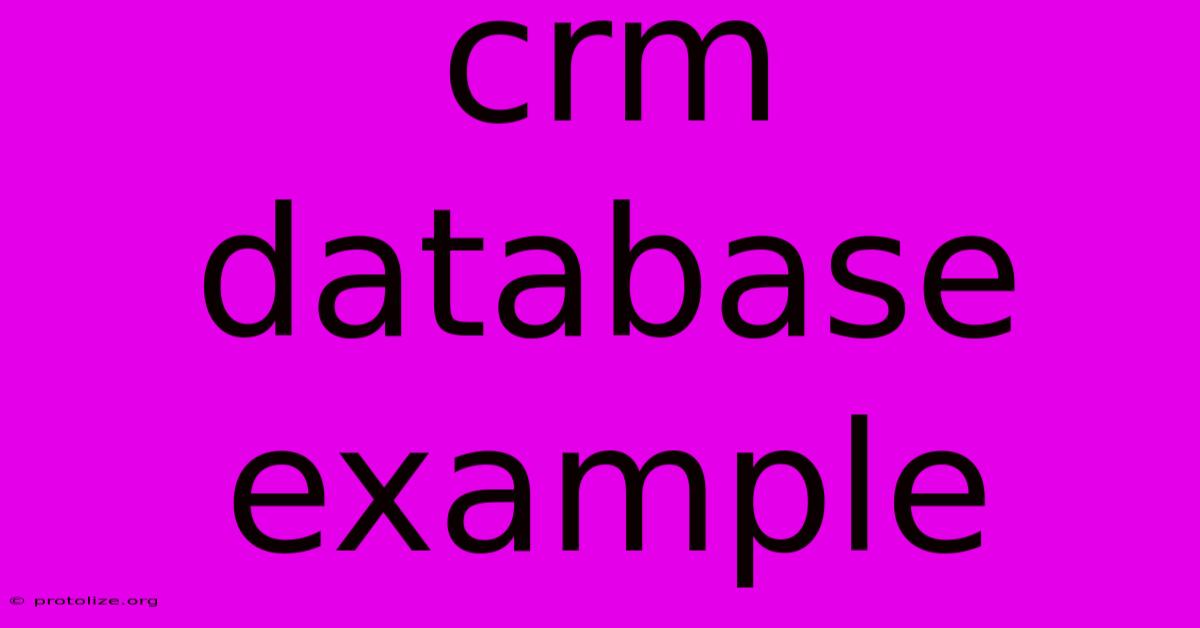Crm Database Example

Discover more detailed and exciting information on our website. Click the link below to start your adventure: Visit Best Website mr.cleine.com. Don't miss out!
Table of Contents
CRM Database Example: A Deep Dive into Structure and Functionality
Choosing the right CRM (Customer Relationship Management) system is crucial for business success. But understanding how a CRM database actually works is equally important. This article provides a detailed look at a sample CRM database structure, highlighting key fields, relationships, and functionalities to help you choose and optimize your own system.
Understanding the Core Components of a CRM Database Example
A CRM database isn't just a simple address book. It's a complex system designed to store, manage, and analyze vast amounts of customer data to improve sales, marketing, and customer service. At its heart lies a relational database, typically using tables linked by keys to ensure data integrity. Let's examine a simplified example.
1. The "Contacts" Table: The Foundation of Your CRM
This table forms the cornerstone of your database, holding core customer information:
| Field Name | Data Type | Description | Example |
|---|---|---|---|
| ContactID | INT (Primary Key) | Unique identifier for each contact | 1, 2, 3, ... |
| FirstName | VARCHAR(255) | Contact's first name | John |
| LastName | VARCHAR(255) | Contact's last name | Doe |
| VARCHAR(255) | Contact's email address | john.doe@email.com | |
| Phone | VARCHAR(20) | Contact's phone number | +1-555-123-4567 |
| Company | VARCHAR(255) | Name of the company the contact belongs to | Acme Corp |
| Address | VARCHAR(255) | Contact's address | 123 Main Street, Anytown, CA |
| Website | VARCHAR(255) | Contact's website | www.example.com |
| LeadSource | VARCHAR(255) | How the lead was generated (e.g., Website, Referral) | Website |
| CreatedDate | DATETIME | Date and time the contact was created | 2024-03-08 10:30:00 |
2. The "Accounts" Table: Managing Businesses
If your CRM deals with businesses, you'll need an "Accounts" table. This table stores information about companies, not individual contacts.
| Field Name | Data Type | Description | Example |
|---|---|---|---|
| AccountID | INT (Primary Key) | Unique identifier for each account | 1, 2, 3, ... |
| AccountName | VARCHAR(255) | Name of the company | Acme Corp |
| Industry | VARCHAR(255) | Industry the company operates in | Technology |
| Website | VARCHAR(255) | Company website | www.acmecorp.com |
| AnnualRevenue | DECIMAL(10,2) | Estimated annual revenue | 1000000.00 |
3. Linking Tables: Establishing Relationships
The power of a relational database lies in its ability to link tables. We can link "Contacts" and "Accounts" using a foreign key:
- Contacts Table: Add an
AccountIDfield (INT, Foreign Key referencing Accounts.AccountID). This links a contact to a specific company.
Now, you can easily retrieve all contacts associated with a particular account.
4. Other Important Tables: Expanding Functionality
A robust CRM system will include additional tables for:
- Opportunities: Tracking sales prospects and their progress.
- Cases/Tickets: Managing customer support interactions.
- Products/Services: Cataloging your offerings.
- Notes: Storing relevant communication details for each contact.
- Tasks: Scheduling follow-up activities.
Beyond the Structure: CRM Database Functionality
A CRM database's structure is only half the story. Its true power lies in its functionality:
- Reporting and Analytics: Generate reports to track sales performance, customer behavior, and campaign effectiveness.
- Workflow Automation: Automate repetitive tasks like email sequences and follow-up reminders.
- Integration with Other Systems: Connect your CRM with email marketing platforms, accounting software, and other tools.
- Customization: Adapt the system to meet your specific business needs.
Choosing the Right CRM: Considerations for your Database
Selecting a CRM involves considering your specific needs. Start by assessing your current data and future requirements. Do you need a simple contact management system, or a complex platform with sales forecasting and marketing automation? The example above serves as a starting point; your actual CRM database will likely be more extensive.
By understanding the structure and functionality of a CRM database, you'll be better equipped to choose a system that effectively supports your business growth and customer relationship management. Remember, a well-structured CRM database is a strategic investment in your company's future.

Thank you for visiting our website wich cover about Crm Database Example. We hope the information provided has been useful to you. Feel free to contact us if you have any questions or need further assistance. See you next time and dont miss to bookmark.
Featured Posts
-
Steelers Win 27 14 Over Browns
Dec 09, 2024
-
Watch Chiefs Vs Chargers Channel Info
Dec 09, 2024
-
Customer Retention In Crm
Dec 09, 2024
-
Panthers Fall Short Against Eagles
Dec 09, 2024
-
Fulham Holds Arsenal Title Implications
Dec 09, 2024
